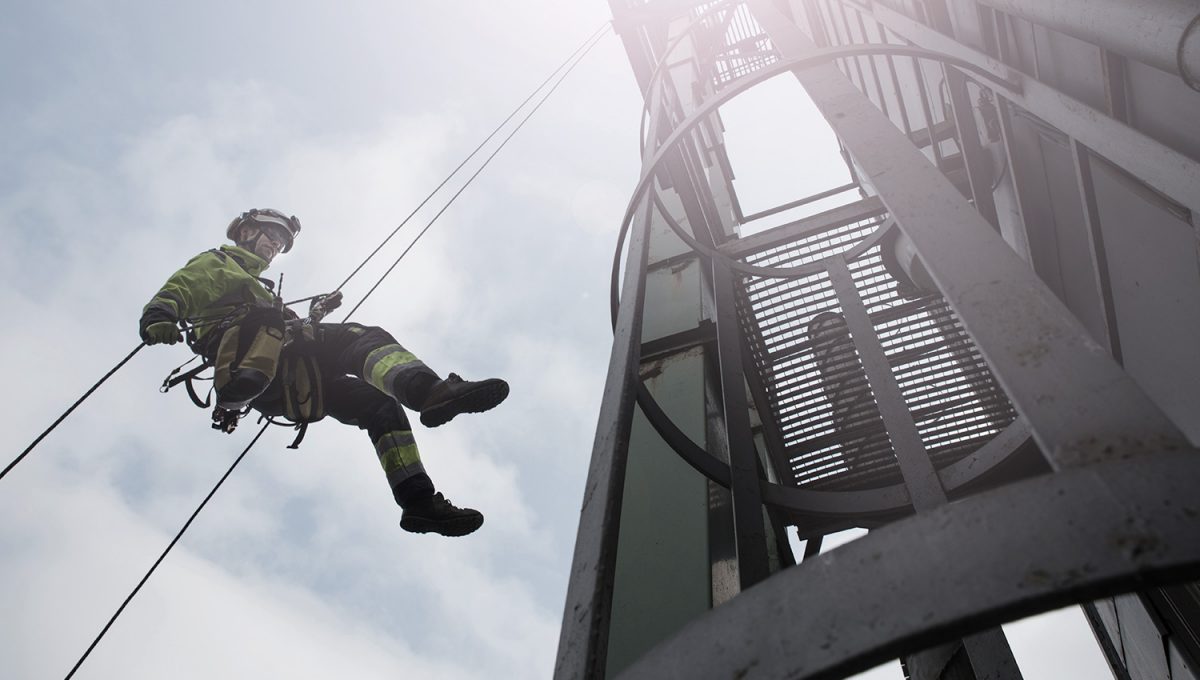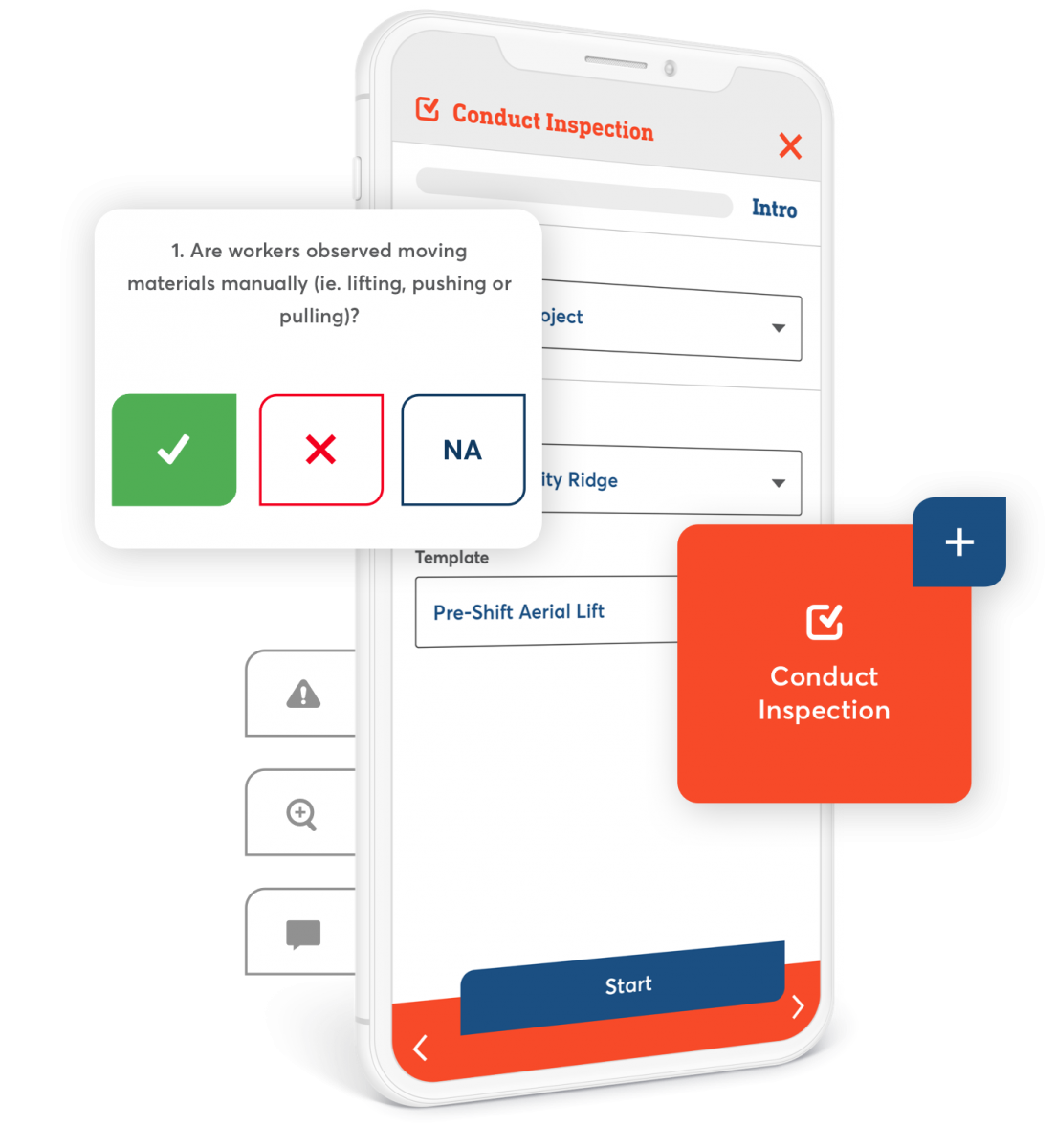Fall protection. It seems like it should be a no-brainer. If someone’s working at heights, they need a fall arrest harness (and a fall arrest system). And yet: OSHA 1926.501 – Fall protection – general requirements was the most cited OSHA violation in 2020. It was also the most cited standard in 2019.
There are many moving parts involved in fall protection, but the fall arrest harness is often the most overlooked. A harness needs to do more than meet OSHA standards. It needs to fit the individual wearing it. Because if the harness doesn’t fit correctly, then the harness could contribute to a preventable workplace fatality, even if the worker is caught and rescued after a fall.
Do your safety harnesses fit your team? And what could happen if they don’t? Here’s a quick guide to fall arrest harness fitting, inspection, and selection.
How to Choose the Right Fall Arrest Harness
We won’t go too deeply into finding the right fall arrest harness brand or other components of fall arrest systems: there’s no shortage of brands and options available on the market. We’ll leave that to your PPE supplier.
Instead, let’s talk about the three most important components of harness selection, whatever your brand choice.
- You must choose a fall arrest harness that meets OSHA requirements per 29 CFR 1910.140 – Personal fall protection systems.
- You’ll find the manufacturing and system performance requirements in 1910.140(c), (d), (e). These cover everything from the manufacture of connectors to limits on the maximum arresting force.
- A harness must match the type of work performed.
- Match the harness to the job type may mean you could need a positioning harness, retrieval harness, or suspension harness. It’s not just the type of lift that matters; work context matters, too. Do you need a high visibility harness or a welding safety harness that’s flame retardant? You’ll answer these questions through your JHA.
- You must select harnesses that will fit your crew correctly. You are unlikely to find that one harness fits every member of the team. People of different heights, builds, and genders will require a different harness.
All three of these factors are equally important, but the one most often overlooked is fit. And the fit of a harness can be a life-or-death problem.
How Harness Fit Could Save (or End) a Life

Grabbing a harness from the box and heading out to the site is a scenario encountered on many job sites around the U.S. and around the world. Often, the thinking is this: “If you have an OSHA-approved harness suitable for the job function, then you’re good to go.”
Unfortunately, that’s not true. There are plenty of ways to get hurt even when the harness fits correctly. The team at Simplified Safety sum this up well:
- A D-ring must sit halfway between the shoulder blades at shoulder blade height. If it’s off-center or too high or too low, any fall will result in injury because your harness won’t equally distribute the forces as you fall.
- A harness must not be too loose or too tight. If a harness is too loose, then your harness won’t control the force as designed, which means instead of falling together, you will keep falling, and could face a rupture where the straps land. When a harness is too tight, it can cut off your circulation.
- The chest strap must sit across your chest. If it’s too high, it can injury your neck, throat, or jaw. When the chest strap fits too low, you could tumble out of the harness during a fall.
Harness Fit Contributes to Suspension Trauma
Another reason harness fit is so critical is that it’s a predictor of the wearer’s suspension tolerance time. In other words, a well-fitting harness will help prevent the rapid onset of “harness-induced death” or “suspension trauma”. These two conditions can cause the death of the harness wearer, even if the harness otherwise worked as designed.
Suspension trauma is called by a phenomenon called “orthostatic incompetence.” It occurs when you must stand for a long period of time without moving. All that’s required for suspension trauma to set in for your legs to remain immobile while you remain upright.
Why is this posture so dangerous? Essentially, gravity pulls the blood into the legs, which reduces blood available to the heart. As the heart tries to compensate, you are likely to faint. If you’re standing on the ground and fall to a horizontal position, then the blood would move back towards the heart.
In a harness, there’s no opportunity for the wearer to faint and assume that horizontal position. In other words, there’s no way to recover in mid-air.
So, when a worker sits suspend in mid-air, it’s critical that their leg straps aren’t too tight, which can speed up the process of suspension trauma, which occurs in only five minutes even with a well-fitted harness.
How to Fit a Fall Arrest Harness
A poorly-fitted harness doesn’t just lower the protection level of the harness. It can even do additional harm in the event of a fall.
Plus, when a harness is ill-fitting or uncomfortable to wear, then workers are more likely to leave it on the ground or make an attempt to modify it. Failing to wear the harness leaves them at grave risk of a fall, and manufacturers agree that modifications weaken the protection offered when worn.
So, after receiving harness samples from a manufacturer or receiving your order, you need to make sure the harness fits the wearer. This should happen first through a safety stand-down anytime you change the harness type or manufacturer. You should also include it in a safety training and orientation program as part of your PPE orientation when work at heights is involved in the worker’s job.
Let’s go through a harness fitting step by step.
Picking up the Harness
- Pick up the harness by the rear attachment point.
- Hold the harness by the dorsal plate and shake to loosen and untangle the straps.
- Once the harness falls naturally, inspect it for any damage. If you see missing stitches, fraying, or worn attachments, DO NOT wear it.
Putting on the Harness
- With the leg straps dangling, put your arm between the two straps and put the harness on like a jacket.
- Ensure the leg straps are hanging down and then fasten them around the legs.
- Tighten the leg straps for a snug but comfortable fit.
- Fasten the chest strap, ensuring the chest strep fits across your chest and not low towards your stomach or high towards your throat.
- At this point, the rear attachment point or D-ring should sit between your shoulder blades both in height and position.
To Fit a Harness
- To fit the straps around the legs, pull the strap through and locate the attachment. Ensure there are no twists in the leg straps. Push the fastener through. Then repeat on the other legs.
- To fit the chest strap, push the strap through the attachment.
- Adjust until there is a snug fit that doesn’t pinch or restrict movement.
- Finish by tucking the strap retainers in to hide loose ends.
How Do You Know if a Fall Arrest Harness Fits?
If you can’t get the dorsal ring to sit in the right place or statute the straps in a way that’s comfortable, then the model isn’t right for the worker! Don’t force it, and don’t send anyone out into the field with a harness that doesn’t fit.
Fall Arrest Harness Dos and Donts
There are a few more pieces after the harness fit that will help you ensure you get all the protection your OSHA-approved safety harness offers. So, we’re offering the Dos and Donts from safety pros to use as reminders in the field.
Let’s start with the Dos.
- Do: Go through the harness fitting process with every worker who will wear a harness on site.
- Do: Tuck in loose ends and loops. Anything loose could get caught in machinery.
- Do: Wear a jacket that has a slot cut in the back for the dorsal ring. Heavy jackets may otherwise interfere with the energy-absorbing element connected to the D-ring.
- Do: Train workers on what to do after a fall when hanging in a harness.
And now a few Don’ts:
- Don’t: Assume one harness brand or type will fit every worker.
- Don’t: Make any modifications or alterations to the harness. Even writing a worker’s name on the webbing can weaken the structural integrity of the harness.
- Don’t: Use a fall arrest system without a rescue plan. Leaving a worker hanging for more than three minutes can result in a fatality due to suspensio trauma.
Inspecting a Fall Arrest Harness
There’s one more key step in ensuring a fall arrest harness is suitable for use on the site. In addition to ensuring every worker wears a well-fitted harness, it’s also important to inspect those harnesses regularly.
1926 CFR 1910.140(c)(18) says: “Personal fall protection systems must be inspected before initial use during each shift for mildew, wear, damage, and other deterioration, and defective components must be removed from service.”
You should also follow the manufacturer’s inspection instructions, where applicable.
What does a safety harness inspection look like? Per OSHA, you should visually inspect the harness for the following defects:
- “Cuts, tears, rips, snags, punctures, abrasions, mold, or stretching
- Alterations or additions which might effect the system’s efficiency
- Damage caused by acids, corrosives
- Distorted hooks or faulty hook springs
- Cracked, broken, or deformed D-Ring, carabiners, grommets, and snaphooks
- Loose, damaged or non-functioning mountings and parts
- Wearing or any internal deterioration in the ropes
- Color fading possibly indicating UV exposure”
Run the Safesite Fall Protection Equipment Inspection: Harness & Lanyard Inspection now.
Any harness deemed to be defective should be tagged as unusable, taken out of service, and destroyed to prevent accident use. Remember: any safety harness involved in a fall event must be destroyed.
Don’t forget to keep documentation for the state of all fall arrest harnesses as part of your equipment or PPE inspection, maintenance, and storage program.
Safesite users can run daily inspections via the Safesite app, which allows workers to complete inspections individually before putting on their harness.
The inspections then appear on your safety management dashboard, so you have a real-time view of your fall protection PPE, missed PPE inspection opportunities, and potential hazards.

Don’t Allow Your Safety Harness to Let You Down
Fall arrest harnesses are a key part of any fall arrest system. However, like all PPE, they must be suited to the job and the wearer. A safety harness that doesn’t fit won’t offer the same protection to the worker. Improperly fitted fall arrest harnesses can even lead to more risks, like suspension trauma or the worker falling out of their harness during a fall.
Fittings and inspections ensure your safety harness stocks won’t let you and your workers down. And you can run them all with Safesite, the only free-forever safety management software. Get started in only two minutes.
